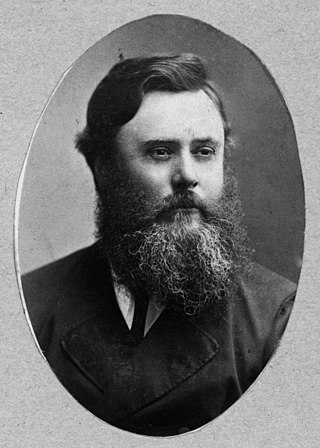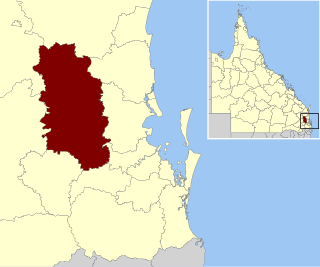Murri is a demonym for Aboriginal Australians of modern-day Queensland and north-western New South Wales. For some people and organisations, the use of Indigenous language regional terms is an expression of pride in their heritage. The term includes many ethno-linguistic groups within the area, such as the Kamilaroi (Gamilaraay) and Yuggera (Jagera) peoples.

The Kabi Kabi people, also spelt Gubbi Gubbi, Gabi Gabi, and other variants, are an Aboriginal Australian people native to South Eastern Queensland. During the Australian frontier wars of the 19th century, there were several mass killings of Kabi Kabi people by settlers. They are now classified as one of several Murri language groups in Queensland. A 2024 determination granted non-exclusive native title rights over an 365,345-hectare (902,790-acre) area of land and waters on the Sunshine Coast.

The Shire of Maroochy was a local government area about 100 kilometres (62 mi) north of Brisbane in the Sunshine Coast region of South East Queensland, Australia. The shire covered an area of 1,162.7 square kilometres (448.9 sq mi), and existed as a local government entity from 1890 until 2008, when it amalgamated with its neighbours to the north and south to form the Sunshine Coast Region.

Cherbourg, formerly known as Barambah, Barambah Aboriginal Settlement and Cherbourg Aboriginal Settlement, is a rural town and locality in the Aboriginal Shire of Cherbourg, Queensland, Australia.

Thomas Petrie was an Australian explorer, gold prospector, logger, and grazier. He was a Queensland pioneer.

The Somerset Region is a local government area located in the West Moreton region of South East Queensland, Australia, western part of Brisbane. The region is centred on the town of Esk, which serves as the council seat. Somerset was created in 2008 from a merger of the shires of Esk and Kilcoy, and is known as the Brisbane Valley, owing to the Brisbane River which courses through the region. However, significant parts of the region lie outside the hydrological Brisbane Valley.

The Maroochy River is a river in South East Queensland, Australia. The river rises from the eastern slopes of the Blackall Range and flows east through Eumundi before entering the sea at Cotton Tree, Maroochydore. Other populated centres in the catchment include Nambour, Eudlo, Yandina and Coolum.

Maroochy Barambah is an Australian Aboriginal mezzo-soprano singer. She is a song-woman, law-woman and elder of the Turrbal people.

The Jagera people, also written Yagarr, Yaggera, Yuggera, and other variants, are the Australian First Nations people who speak the Yuggera language. The Yuggera language which encompasses a number of dialects was spoken by the traditional owners of the territories from Moreton Bay to the base of the Toowoomba ranges including the city of Brisbane. There is debate over whether the Turrbal people of the Brisbane area should be considered a subgroup of the Jagera or a separate people.
Turrbal is an Aboriginal Australian language of the Turrbal people of the Brisbane area of Queensland.
Wakka Wakka, or Waka Waka, people are an Aboriginal Australian people of the state of Queensland.

Murrumba Homestead Grounds is a heritage-listed site at 38 Armstrong Street, Petrie, City of Moreton Bay, Queensland, Australia. It was added to the Queensland Heritage Register on 16 February 2009.

The Yugambeh, also known as the Minyangbal, or Nganduwal, are an Aboriginal Australian people of South East Queensland and the Northern Rivers of New South Wales, their territory lies between the Logan and Tweed rivers. A term for an Aboriginal of the Yugambeh tribe is Mibunn, which is derived from the word for the Wedge-tailed Eagle. Historically, some anthropologists have erroneously referred to them as the Chepara, the term for a first-degree initiate. Archaeological evidence indicates Aboriginal people have occupied the area for tens of thousands of years. By the time European colonisation began, the Yugambeh had a complex network of groups, and kinship. The Yugambeh territory is subdivided among clan groups with each occupying a designated locality, each clan having certain rights and responsibilities in relation to their respective areas.
The Ngugi are an Aboriginal Australian people, one of three Quandamooka peoples, and the traditional inhabitants of Moreton Island.
The Djindubari, also written Jindoobarrie or Joondubarri, are or were an Aboriginal Australian people of southern Queensland, whose traditional lands were located on Bribie Island. They are thought to be a horde or clan of the Undanbi.
The Dalla, also known as Jinibara, are an indigenous Australian people of southern Queensland whose tribal lands lay close to Brisbane.

Dundalli was an Aboriginal lawman who figured prominently in accounts of conflict between European settlers and indigenous aboriginal peoples in the area of Brisbane in South East Queensland. Traditionally described as a murderer, savage and terrorist, he is now thought variously to have been a guerilla leader or to have coordinated a decade-long resistance to white colonization the area. He was hanged publicly in Brisbane in 1855 by order of the Sheriff of New South Wales.
The Nunukul, also spelt Noonuccal and known also as Moondjan are an Aboriginal Australian people, one of three Quandamooka peoples, who traditionally lived on Minjerribah, in Moreton Bay Area and in mainland Brisbane regions.
The Undanbi are an Aboriginal Australian people of southern Queensland. Alternative or clan names include Inabara, Djindubari and Ningy Ningy.
John Fahy, also known as Gilburri, was an escaped Irish convict who lived with the Wakka people of the South Burnett in Queensland, Australia.